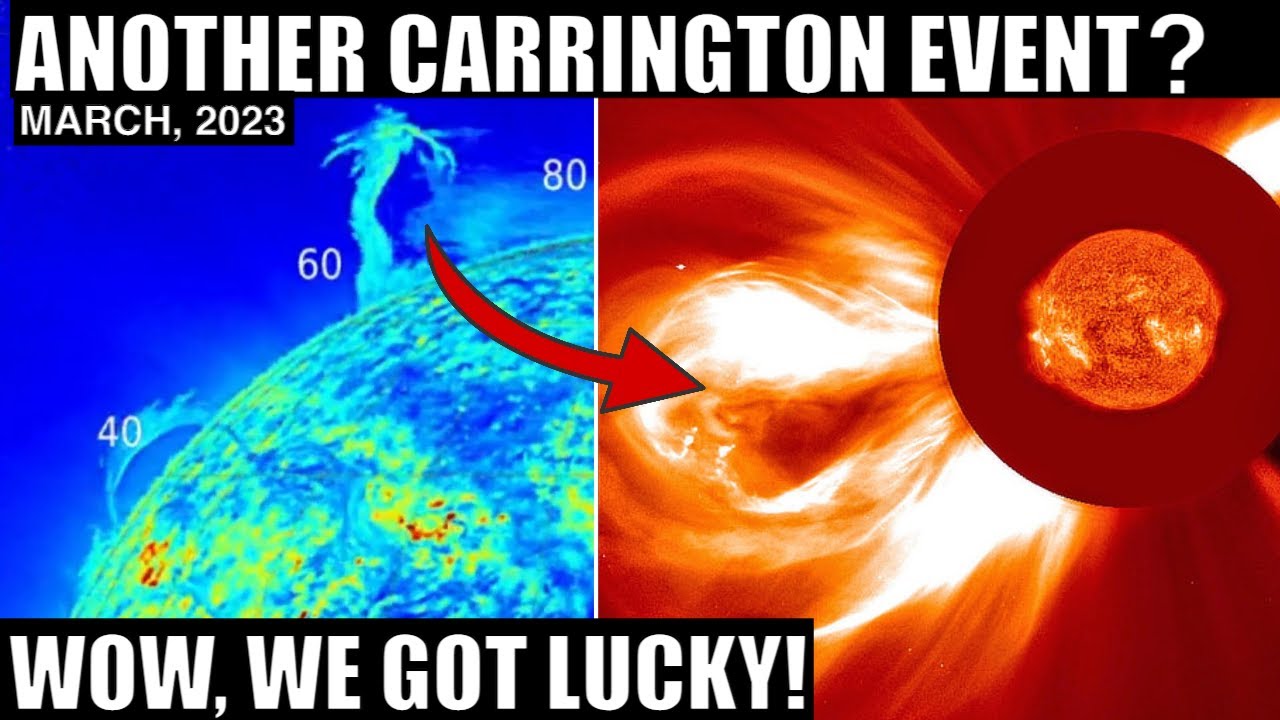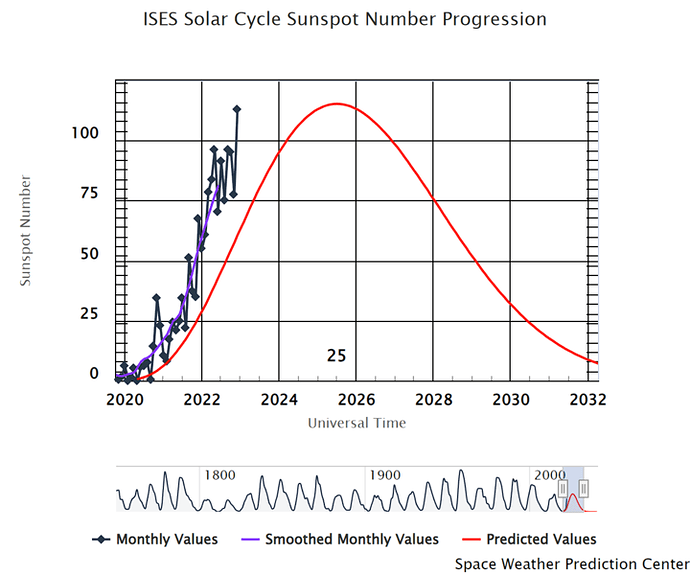On 2023-03-13 a massive coronal mass ejection (CME) occurred on the far side of the Sun. Observations by solar monitoring spacecraft showed particles ejected from the Sun travelling at 3000 km/sec (around 1% of the speed of light), and the quantity of mass ejected one of the largest ever observed, possibly comparable to or larger than the Carrington event of 1859. Particles from the event crossed the Earth’s orbit around twenty hours after being ejected from the Sun, but fortunately (and due purely to luck), the Earth was on the other side of its orbit at the time.
A few weeks earlier, a plume of plasma was observed erupting at high solar latitude, apparently forming a vortex-like structure around the Sun’s north pole. Nothing like this has been seen before; whether there is any connection with the subsequent CME is unknown. The consensus prediction for the current Solar Cycle 25 is that it will peak in July 2025 (± 8 months) and be weaker than the recent average. Observations so far, however, are running above predicted activity.
A CME of this magnitude may have devastating consequences for the power grid and technological infrastructure of many developed countries. We got lucky this time, but luck is not a strategy.
10 Likes
All the hard fact and likely consequences of an “unlucky” CME are well known to our omniscient and omnipotent betters. Years ago, both congressional and presidential studies were published with recommendations. Our betters are so concerned with our wellbeing, as they tell us continuously, they have taken steps to harden the grid… Oh! They haven’t!? They are too busy enacting laws to ensure on demand abortion (including fetal craniotomy at birth) and denying even the right to question teen genital self-mutilation against their parents’ wishes.
Is it the excessive cost of hardening the grid? Nope. That would fall within a rounding error of one year’s budget. I suspect it’s simpler. They rightly figure there will be no one left to object when (not if) this particular extinction level event occurs. It also seems they already understand there are no consequences for anything they do or do not do; they wield the law as a weapon when it suits and ignore it as they wish, as would be expected in a “nation of laws”, not of men. That’s what happens when the “media” are a subsidiary of the Stalinist dem party. Another glaring example of this alliance is seen for example, in media portrayal of inflation. Were a repub in the White House, the difficulties of rapidly shrinking buying power would be blaring 24/7. Now - with a mumbling, stumbling, decorticate wraith at the helm - crickets.
7 Likes
“ Crickets”? Awww, now you’re makin’ me hungry….
5 Likes
I’ve argued on my blog that the danger from a repeat of the Carrington event is overrated – yes, even by NASA:
https://yarchive.net/blog/carrington-event/
4 Likes
There is a lot of over-hyped panic about the threat of EMP attacks and the similar consequences of a geomagnetic storm resulting from impact of a coronal mass ejection on the Earth. I discussed this in my review of William Forstchen’s 2009 novel One Second After (link is to my review). The best source I’ve found an for experimentally-based assessment of the risks is the April 2008 “Critical National Infrastructures” [PDF] report by the Commission to Assess the Threat to the United States from Electromagnetic Pulse (EMP) Attack. They actually set up an EMP generator and tested automobiles, avionics, and a variety of other devices to see what would happen. There are risks which should be mitigated, but the reality seems much less dire and exciting than you’d conclude from the hyperventilating headlines and stories in the popular press.
Of course, when assessing risks, there’s always the question of the “unknown unknowns”—the things that break that you didn’t think of before the event happens. It’s likely there will be some of this in the aftermath of a coronal mass ejection impact on the Earth’s magnetosphere.
6 Likes
EMP is a much more serious threat. As I wrote in that blog post,
The risk from monster solar flares is often compared to the risk from nuclear electromagnetic pulse. There is a great deal of similarity, but solar flares lack the “pulse” part. A high-altitude nuclear burst creates lots of charged particles which distort the Earth’s magnetic field in much the same way that solar flares do, and thereby pose the same sort of risk to the power grid, but nuclear EMP also generates a lot of high-frequency electromagnetic energy. That above-quoted line about solar flares “disabling everything that plugs into a wall socket” is, in context, merely talking about what happens when the power goes off and stays off. But with nuclear EMP, enough energy might come roaring down the power lines (collected by all those miles of wire acting as an antenna) to actually fry devices that are plugged into them. It still would have a hard time frying devices that aren’t plugged into anything, though. Despite much talk of it killing the electronics in cars, when the federal EMP Commission did tests on cars in the early 2000s, nothing particularly dire happened to them: the worst was that they had to be restarted. But there still is quite a lot that is plugged in, and the risk to it is worth respecting.
If that bit on cars seems to echo your Forstchen review, well, I did read that review when it came out – but I also read the EMP commission report itself. Another thing that report states is that the risks from the E3 pulse (the part of EMP that is similar to the results of solar flares) are serious because the E1 and E2 pulses may fry monitoring electronics which safeguard the power grid against things like solar flares. The industry does know about the risk from solar flares: in one episode they fried big transformers in Canada. So they do invest in monitoring equipment to avert that risk; it’s relatively simple equipment that does not require a big budget. And of course NASA is on the job too, as witness the headline “Large Coronal Mass Ejection on Far Side of the Sun” that started this discussion. Yes, they’re overhyping the risk, but their monitoring work does deserve to be continued.
7 Likes

